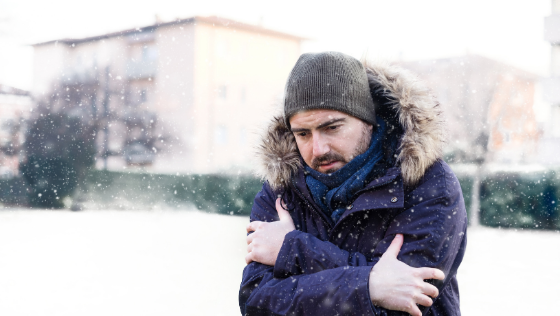Cold Stress — Know The Signs & Symptoms

Cold stress is a condition caused by excessive exposure to extreme conditions including low temperatures, wind, and/or moisture. Unfortunately, winters in New England, make cold stress injuries a lot more common than you might think.
Vulnerable people include but are not limited to outdoor workers, those that work in poorly heated or insulated areas, those with reduced blood circulation, as well as those who have not dressed appropriately for extreme, cold conditions.
If you work in conditions that could lead to a cold stress injury, below we outline two of the most common types of injuries & how to treat them whether they happen to you or someone you know.
- Frostbite is an injury to the body caused by freezing; most often affecting the nose, ears, cheeks, chin, fingers, or toes. Superficial frostbite affects the skin surface, however, if the condition can progress to deep frostbite, all layers of the skin are affected, and the outcome tends to be more serious. Severe cases may lead to permanent damage to the body and/or amputation. It should be noted that protected areas may still be subject to frostbite.
Symptoms:
- Reduced blood flow, especially to the hands and/or feet
- Tingling, stinging, and/or aching
- Numbness
- Pail white or grayish-blue skin that is cold and numb
Treatment:
- Get indoors immediately
- Remove constrictive clothing that could interfere with circulation
- Immerse affected area in warm water (not hot water)
- Elevate the affected area to reduce pain and/or swelling
- DO NOT use direct dry heat from a heating pad, lamp, fireplace, etc. as the affected areas can easily be burned
- DO NOT rub or massage the area as this may result in further damage
- If necessary, seek medical attention
- Hypothermia occurs when your body begins to lose heat faster than it can be produced after exposure to cold temperatures resulting in an abnormally low body temperature. A low body temperature affects the brain, making the victim unable to think clearly and/or move properly.
Early symptoms:
- Severe shivering (the first sign) allows the body to stay warm; however, once this energy is used up; shivering results in the following:
- Drowsiness and/or exhaustion
- Fatigue
- Confusion and/or disorientation
- Loss of coordination and/or slurred speech
Late Symptoms:
- Shallow breathing, and/or irregular heartbeat
- Grayish blue skin
- Dilated pupils
- Unconsciousness
Treatment:
- Move the victim inside and remove any wet clothing
- Call for medical attention
- Warm chest, neck, and headfirst by applying blankets, clothing, towels, and/or sheets
- Keep the victim in a horizontal position
- Handle the victim gently to avoid cardiac arrest
- If conscious, warm liquids may help increase body temperature
- If necessary, give CPR
Now that you know the signs & symptoms of common cold stress injuries, here are some safety measures you can take to prevent them from happening in the first place, whether it be at your place of business or even your home.
- Train your employees to recognize signs of cold stress, proper PPE usage, etc.
- Develop and create an outline for first aid and emergency medical procedures.
- Adjust schedules, so that cold jobs are performed during the warmest part of the day.
- Wear proper clothing & equipment. It is important to layer clothing, do not wear anything tight-fitting, and keep a change of dry clothes handy.
- Eat & drink warm foods and/or liquids.
- Take frequent breaks, and move into warm locations during those breaks.
- Avoid alcohol, caffeine, and nicotine use as it increases heart rate, blood flow, loss of body heat.





